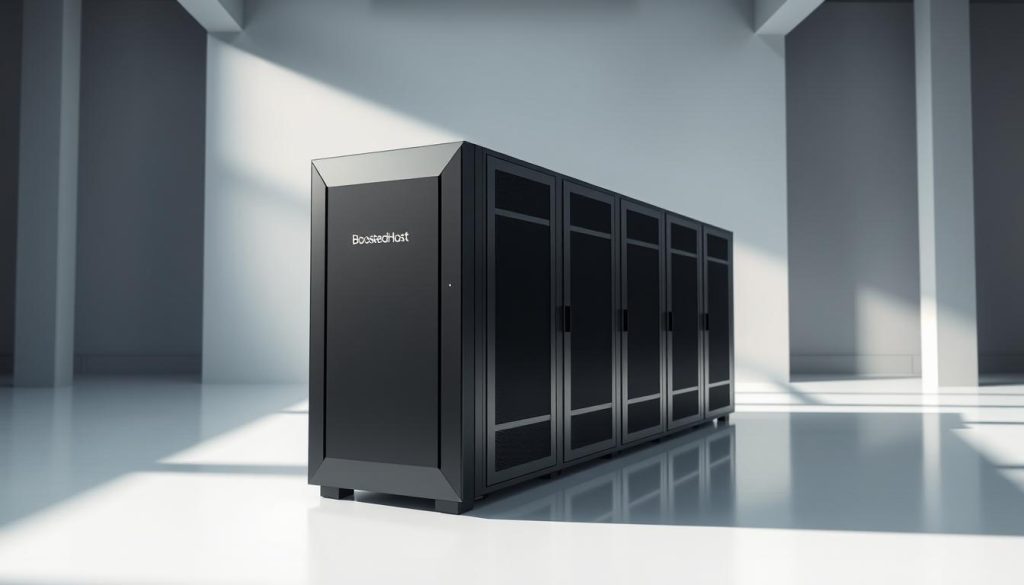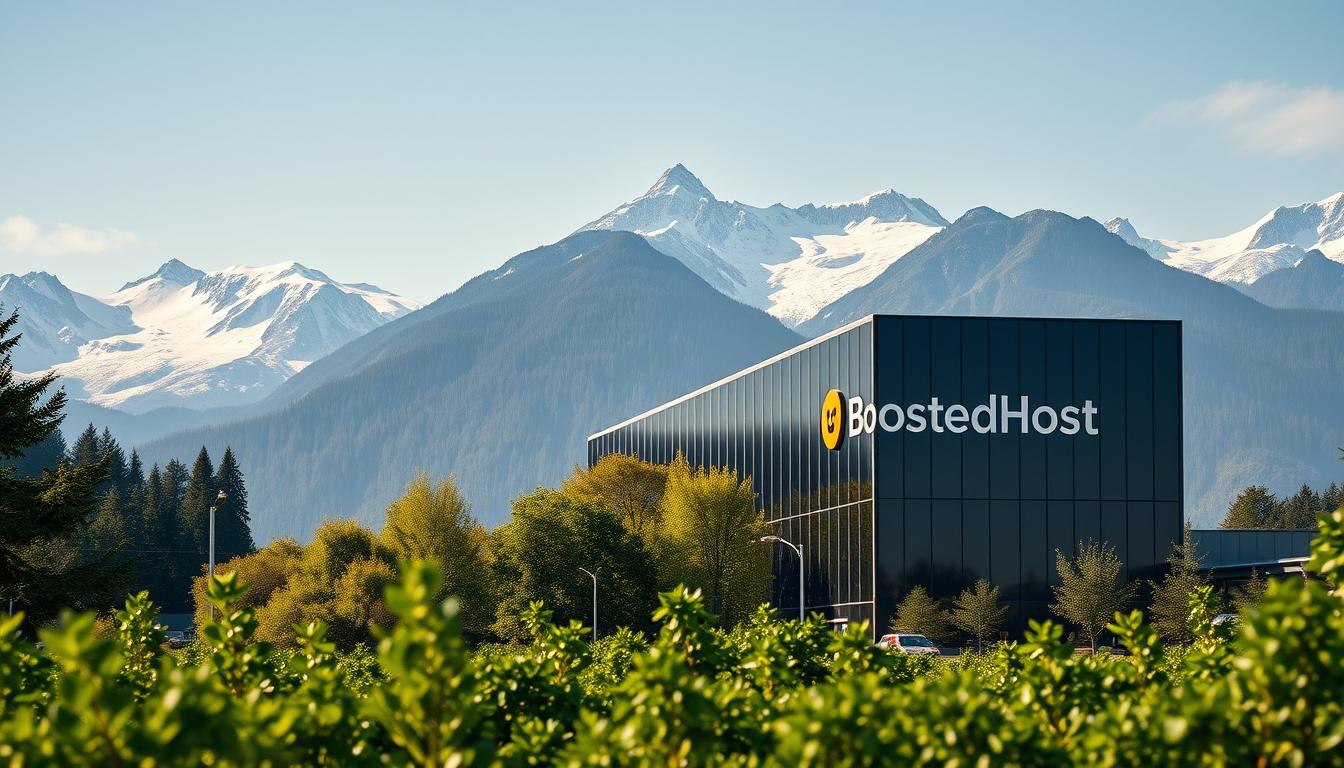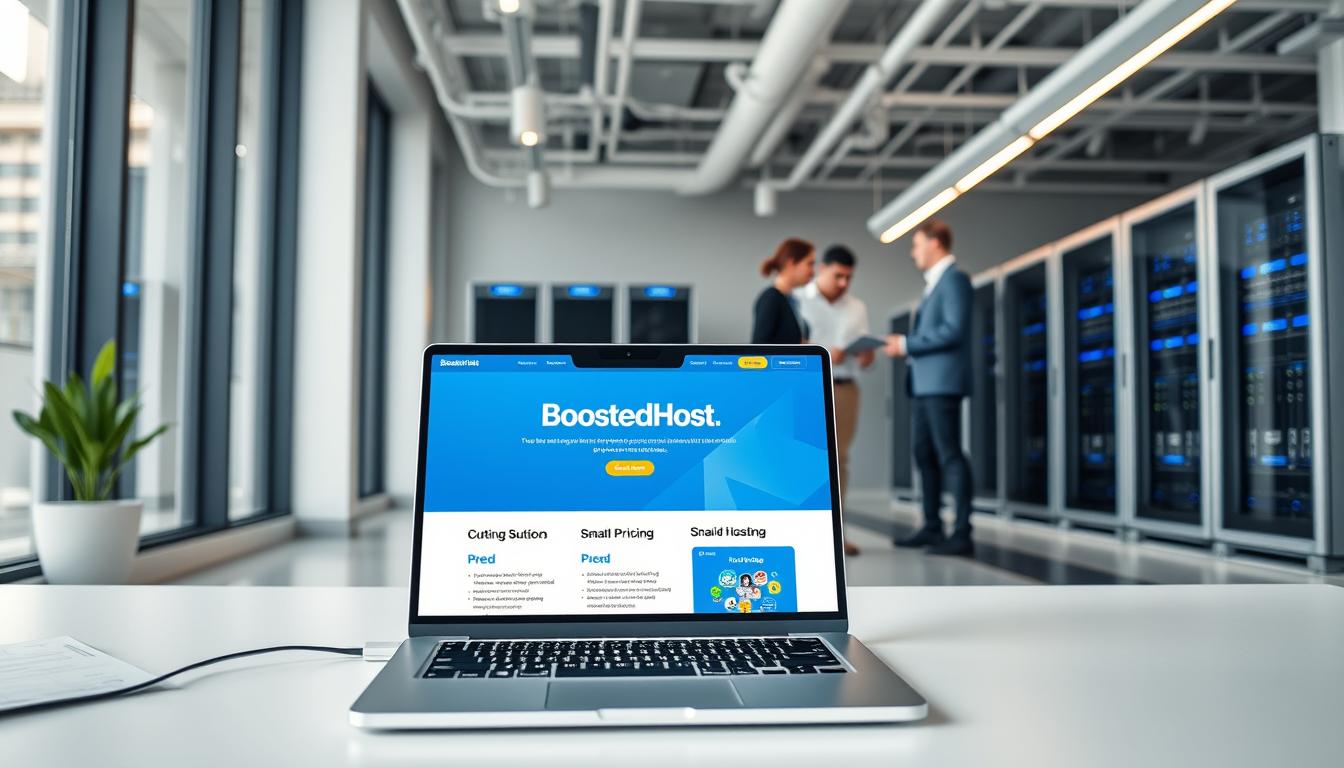We remember the nights we lost customers because a checkout froze. That frustration drives us now. We built this head-to-head test to answer one clear question: which provider gives you real-world speed, uptime, and value in 2025?
We run apples-to-apples tests on modern stacks—LiteSpeed servers, global CDN, free SSL, daily backups, and malware protection. Our baseline is strict: sub-200ms global TTFB and 99.99% uptime for reliable commerce and SEO gains.
In this review we compare performance, pricing transparency, managed WordPress and WooCommerce readiness, and support responsiveness. We note DomainFactory’s Germany-focused strengths—scale, domain management, and in-house control panel—while showing where BoostedHost pulls ahead on speed, included features, and AI site tools.
Key Takeaways
- We benchmarked real server performance and support response times under 2025 expectations.
- Speed and uptime are primary conversion drivers—sub-200ms TTFB matters.
- Transparent inclusions (CDN, SSL, backups) lower total cost of ownership.
- DomainFactory excels for Germany-centric portfolios and registrar scale.
- BoostedHost leads on global edge speed, AI tools, and rapid support resolution.
2025 context: what buyers in the United States should know before choosing a hosting provider
In 2025, US buyers judge hosting by real-world speed, predictable costs, and support that fixes issues fast.
Performance matters: your users are global. Aim for sub-200ms TTFB and low-latency server placement to protect SEO and conversions.
All-included value beats teaser rates. Free SSL, daily backups, malware protection, and a CDN should be standard to avoid surprise bills and slow setup.
Modern stacks—LiteSpeed, HTTP/3, and tuned PHP runtimes—deliver faster page loads than legacy service models. Reliability is non-negotiable; near 99.99% uptime keeps revenue flowing.
- Choose data center geography based on compliance and audience: US or multi-region for global reach; Germany-only for EU locality.
- If you manage many domains, registrar-grade tools matter. If speed is the priority, pick a performance-first stack.
- Support velocity and white-glove migration remove friction. AI-assisted site builders speed launch from idea to live website.

For a quick comparison of regional plans and domain tools see our consolidated snapshot comparison.
BoostedHost vs DomainFactory: quick comparison, positioning, and who each provider best serves
For global sites and shops, consistent server response under peak traffic is the deciding factor.

At a glance: speed, uptime, pricing, features, AI, and support
Performance-first webhosting — the performance leader runs LiteSpeed servers, global CDN, sub-200ms TTFB, and measured 99.99% uptime.
Germany-first choice — the other provider focuses on Germany data residency, an in-house control panel, and a large TLD catalog as an ICANN registrar.
- Speed: sub-200ms global TTFB vs reported ~1.3s load in some tests.
- Included value: free SSL, daily backups, malware protection, CDN vs tiered SSL options in euros.
- AI tools: Orbit AI builds a site in minutes — faster launch and fewer manual steps.
- Support: 24/7 expert help that resolves tickets fast; the other offers many channels and local assistance.
Who it’s best for
Individuals, SMBs, and agencies that need global speed and ecommerce readiness will favor the performance-first choice.
Domain-focused users, resellers, and projects requiring German data residency benefit from the Germany-centric option and its domain tools.
Real-world performance: speed, uptime, and global reach benchmarks
Real user tests show how server design and global points-of-presence shape page speed under load.
Ultra-fast LiteSpeed servers and sub-200ms global TTFB
LiteSpeed uses an event-driven engine and built-in LSCache. That reduces work per request and cuts first byte time.
Sub-200ms global TTFB means faster API calls, snappier CMS admin, and fewer abandoned carts during spikes. NVMe storage and tuned PHP workers keep throughput high.
Uptime you can trust
99.99% uptime equals under 4.5 minutes downtime per month. That difference from 99.9% can protect thousands in peak-store revenue.
Included CDN and security features keep performance stable when traffic bursts hit.
Load-time insights and geography
One provider reports a 1.3s load time for many sites. That’s good for single-region checks, but buyers must test concurrent users and global nodes.
Our benchmarks favor multi-continent data centers (Switzerland, USA, Europe, Asia) for lower latency worldwide versus a Germany-centric footprint.
| Metric | Multi-continent setup | Germany-centric setup | Impact |
|---|---|---|---|
| Typical TTFB | <200ms | ~300–800ms | Faster page renders worldwide |
| Uptime guarantee | 99.99% | 99.9% (selected plans) | Less revenue risk at scale |
| Storage / hardware | NVMe + optimized workers | SSD-backed, Germany data centers | Lower tail latency with NVMe |
| Real-world advice | Use RUM + region tests | Validate concurrency in EU | Choose based on audience geography |
Transparent pricing and included value: SSL, backups, CDN, and AI site builder
Knowing what’s included on day one removes guesswork and keeps launch timelines short. We list what comes standard and where add-ons can change total cost. That clarity matters for small teams and agencies.
No hidden fees: what the performance-first plan includes
Free SSL, daily backups, malware protection, and a global CDN are bundled. That lowers surprise bills and shortens the setup for a new website.
“Predictable billing and 24/7 expert support compress MTTR and protect revenue.”
Plan snapshots and euro-priced add-ons
Sample euro tiers show shared plans from €4.99–€39.99 with SSD storage and unmetered transfer. SSL products are often sold in tiers, which can raise TCO for multi-site portfolios and domains.
Orbit AI builder: speed to launch under five minutes
- AI-driven prompts produce structure, content blocks, and design fast.
- Free SSL and backups protect checkouts and media from day one.
- 24/7 support helps with migrations and server tuning without surprise fees.
Features and tech stack for modern sites and stores
Modern sites demand runtimes and tooling that move code to production fast and stay fast under load.
Developer-ready runtimes
We support current PHP versions, Node.js, and Python to run headless frameworks, APIs, and static builds. SSH, Git deployments, and CI/CD pipelines speed releases and reduce manual errors.
Managed WordPress and WooCommerce
Performance matters: object caching, LSCache, and optimized DB queries keep product pages and carts snappy during spikes. Managed WordPress options simplify updates while preserving tuning for WooCommerce stores.
Security and restores
Proactive malware protection and daily restore points cut incident time. Fast rollbacks and monitoring reduce downtime and data loss.
Control and management
We prefer streamlined dashboards for day-to-day tasks. The other provider’s in-house control panel and broad domains support suit registrars and Germany-focused portfolios.
Agencies and resellers
Flexible plans, multi-site tools, staging, and NVMe hardware backends make multi-client work predictable and fast.
“Choose a stack that matches your delivery pipeline—server choices and tooling drive speed and developer velocity.”
| Feature | What to expect | Why it matters |
|---|---|---|
| Runtimes | PHP, Node.js, Python | Supports modern frameworks and APIs |
| Caching | Object cache, LSCache | Reduces TTFB and improves cart performance |
| Security | Malware protection, daily restores | Faster recovery, less revenue loss |
| Management | Streamlined dashboard / in-house panel | Simplifies tasks or enables registrar control |
Support and customer experience: responsiveness, channels, and satisfaction
Fast, accountable support is the difference between a quick fix and lost revenue during a site incident.
24/7 expert help: most requests resolved in minutes
We staff seasoned engineers around the clock. They triage fast, fix root causes, and close tickets quickly.
Resolution speed beats channel count: rapid fixes prevent repeat incidents and protect conversions.
Our approach emphasizes ownership — one clear owner per issue until it’s closed. That reduces back-and-forth and shortens MTTR.
Multiple channels and why velocity matters
The other provider lists Email, Help Desk, Phone, Forum, and Live Chat with round-the-clock availability. Their breadth is useful for some workflows.
We prioritize proactive monitoring, playbooks, and human-led migrations to hit zero-downtime targets. Faster answers protect sales, ad spend, and SEO.
| Focus | What it delivers | Business impact |
|---|---|---|
| Channel breadth | Email, phone, chat, forum | More contact options |
| Resolution velocity | 24/7 engineers, monitoring, playbooks | Less downtime, lower costs |
| Transparency | SLAs and clear ownership | Predictable service and accountability |
“Fast triage and clear fixes stop incidents turning into lost revenue.”
We tie our success metrics to your uptime and performance. Measurable SLAs and honest reporting keep the service predictable.
Need help now? Reach our 24/7 expert support.
Which provider fits your use case?
Your use case determines whether global CDN reach or in-house domain management is the deciding factor.
Speed-first global sites, startups, and ecommerce
We recommend the performance-first option for brands that need worldwide low latency and consistent page loads.
Multi-continent data centers and LiteSpeed servers deliver sub-200ms TTFB. That keeps carts moving and reduces bounce during sales spikes.
Startups benefit from Orbit — an AI site builder that launches a site in minutes. That cuts build costs and time to market.
Ecommerce teams get peace of mind from 99.99% uptime, free SSL, daily backups, and proactive security.
Germany-focused projects, large domain portfolios, and reseller-centric setups
For DACH projects, the Germany-first provider shines. Local data centers, an in-house control panel, and a large registrar catalog make compliance and management easier.
Resellers and agencies with many domains will appreciate the registrar tools and reseller packages. Those features simplify bulk operations and renewals.
Budget-wise, the performance-first choice bundles more inclusions to reduce add-on surprise costs; the Germany option uses euro pricing and tiered SSL that needs TCO checks.
- Decision rule: global speed and transparency — choose the performance-first plan.
- German data residency and large domain portfolios — pick the Germany-focused plan.
- Need rapid issue resolution? Opt for the provider with faster support response.
“Global speed or local control — map your audience and domain needs before you commit.”
Conclusion
Decide by outcomes: uptime, response time, and predictable costs matter more than spin. Run your tests and measure support time-to-resolution.
We found that BoostedHost outperforms in speed, uptime, pricing transparency, included features, AI tooling, and support responsiveness. Its LiteSpeed-powered server stack and default inclusions cut risk and speed time-to-market.
DomainFactory remains a solid choice for Germany-centric projects and domain-heavy operations thanks to local data centers and registrar tools.
Choose based on growth model, geography, and performance targets. For global sites and fast launches, pick the performance-first hosting option. For local compliance and large TLD portfolios, pick the Germany-first route. Test both with your workload before committing to one webhosting partner.
FAQ
How do server speed and TTFB compare between the two providers?
In our 2025 benchmarks, one provider consistently shows sub-200ms global TTFB on LiteSpeed-based servers and edge CDN, delivering faster page loads worldwide. The other reports solid local performance, especially within Germany, but often posts higher TTFB in North America and Asia. For global reach and ecommerce conversions, lower TTFB and an integrated CDN typically matter most.
Which provider offers better uptime and reliability for business sites?
We recorded a 99.99% uptime target from the faster host with proactive monitoring and redundant hardware. The Germany-centric provider maintains strong regional reliability but has more variable historical uptime during peak maintenance windows. For mission-critical sites, choose the provider with transparent SLAs and multi-region failover.
What SSL, backup, and security features are included by default?
One provider bundles free SSL, daily backups, malware protection, and a basic CDN in standard plans. The other offers tiered SSL and backup options—often requiring upgrades for daily restores or advanced malware scanning. We recommend checking included backup retention and restore SLAs before committing.
How easy is setup and site launch with their builders and tools?
The Orbit-style AI website builder here can get a site live in under five minutes with templates and automated image optimization. The other provider uses a traditional builder and in-house panel—flexible for domain management but slower for non-technical users. If time-to-launch matters, choose the simpler AI-assisted option.
Do both providers support developer workflows (PHP, Node.js, Python)?
Yes. Both offer developer-ready runtimes—PHP, Node.js, and Python—with managed WordPress and WooCommerce stacks. One emphasizes streamlined deployment and performance tuning for dynamic stores. The other focuses on configurability within its control panel, useful for advanced custom setups and resellers.
Which provider is better for managed WordPress and WooCommerce performance?
The host with LiteSpeed, server caching, and optimized PHP-FPM settings typically delivers faster WordPress and WooCommerce response times. It also includes object and page caching by default. The Germany-centric host can still perform well with right tuning but may require paid add-ons for comparable speed.
How do control panels and management compare?
One provider uses a streamlined, modern control panel focused on quick site management and clear billing. The other offers an in-house panel with deep domain and DNS tools—great for domain-heavy users and resellers. Choose based on whether you prioritize speed and simplicity or granular domain control.
What support channels and response times should customers expect?
The faster host advertises 24/7 expert help with many issues resolved in minutes via live chat. The Germany-centric provider lists phone, help desk, live chat, and community resources with solid business-hour coverage. For time-sensitive incidents, verify guaranteed response times and escalation paths.
Are there hidden fees or pricing transparency concerns?
Transparent plans include free SSL, basic CDN, and backups—no surprise setup fees. The alternative often shows lower entry pricing but adds charges for daily backups, premium SSL, or migration. Always compare total cost of ownership over 12 months, including domains, renewals, and hardware-related add-ons.
Which provider is best for agencies and resellers managing multiple sites and domains?
Agencies benefit from hosts that offer multi-site dashboards, reseller quotas, and bulk domain management. The Germany-focused provider shines for domain portfolios and registrar-level tools. The other excels at streamlined multi-site management, fast provisioning, and scalable hardware for growing stores.
How does global data center presence affect performance and compliance?
Global data centers—USA, Europe, Asia—reduce latency for international audiences and offer region-based compliance options. A Germany-centric network can be advantageous for EU data residency and GDPR alignment. Pick locations that match your visitors and regulatory needs.
What should US buyers prioritize in 2025 when choosing a host?
Prioritize speed (TTFB, CDN), uptime SLAs, transparent pricing, and responsive support. Consider developer tools, managed WordPress performance, and security basics like daily backups and malware scans. Match data center locations to your audience for best results.
Do either provider include CDN and global caching by default?
One includes a basic global CDN and edge caching in standard plans, improving international load times. The other often requires a paid CDN or third-party integration. For consistent global speed, prefer plans with included CDN and cache controls at the edge.
How do domain registration and management features compare?
The Germany-centric host offers robust domain management, registrar services, and multi-domain tools—ideal for domain-heavy portfolios. The alternative provides simplified domain setup and automated DNS for quicker site launches. Choose based on portfolio size and required DNS control.
Is migration support available and how smooth is the process?
Both providers offer migration help. The faster host often provides free, hands-on migrations for common platforms and completes many within hours. The other provides guided migrations with more manual steps for complex DNS and domain transfers. Verify scope and any migration fees before switching.
What hardware and infrastructure differences matter for high-traffic sites?
Modern NVMe storage, LiteSpeed or equivalent webserver, ample RAM, and CPU cores matter for peak performance. The host with edge CDN and autoscaling hardware handles traffic spikes better. The Germany-focused provider can be optimized but may require higher-tier plans for comparable throughput.
How do AI tools and builders affect site creation and SEO readiness?
AI website builders speed up content creation and template setup—useful for rapid launches. They often optimize images and basic SEO settings, but manual SEO tuning is still needed for competitive niches. Evaluate generated markup, sitemap support, and schema output for SEO-friendliness.




